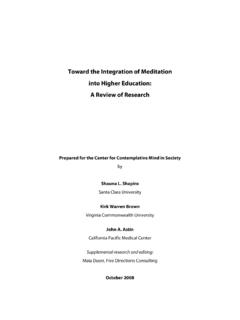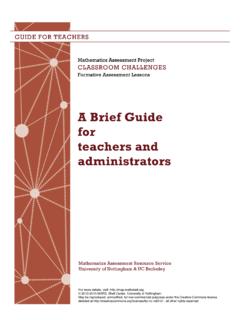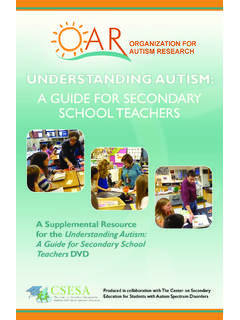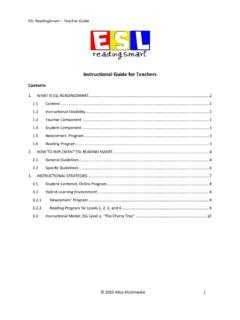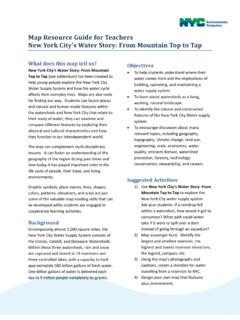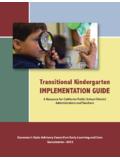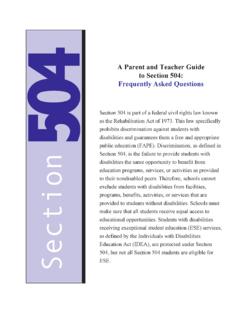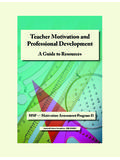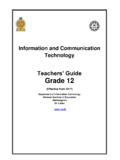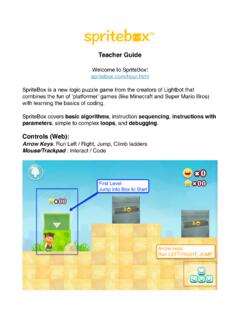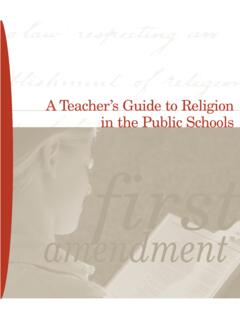Transcription of Mindfulness: A Guide for Teachers
1 Author s note: Minimal alterations to this document are permitted in the name of making mindfulness accessible to more children, adolescents, Teachers and schools. Specifically, you may wish to remove the reference to Buddhism in the last sentence of the third paragraph. If you wish to make any other alterations or have questions or requests please contact Dr. Amy Saltzman at mindfulness : A Guide for Teachers By Dr. Amy Saltzman What Is mindfulness ? This brief document provides a working definition of mindfulness , an overview of the scientific rationale for offering mindfulness to children and adolescents, a review of the professional and personal benefits of practicing mindfulness , specific suggestions for eveloping your own mindfulness practice (which is a prerequisite to sharing mindfulness dwith your students), and two examples of practices you can use in your classroom.
2 While there are many definitions of mindfulness , the definition I use with children and adolescents is: mindfulness is paying attention to your life, here and now, with kindness and curiosity. One of the primary ironies of modern education is that we ask students to pay attention dozens of times a day, yet we never teach them how. The practice of indfulness teaches students how to pay attention, and this way of paying attention menhances both academic and social emotional learning. As human beings we have the unique capacity to pay attention to/be aware of our internal and external worlds and the interactions between the two. We can attend to the breath, the body, thoughts, emotions, tastes, smells, sights, sounds, and our impulses and actions and their effects on others and our environment.
3 This ability to pay attention is a natural, innate uman capacity. One does not need to be Buddhist to pay attention in this way, any more han one needs to be Italian to enjoy pizza. ht Why Is mindfulness Important? Stress and Learning As a classroom teacher , you already know that many of your students are stressed. For some, the stress is simply living in our fast paced, media saturated, multi tasking world. For others, the stress is performing, succeeding, and getting into a good college. For still others the stress is surviving in extremely challenging, even traumatic, home environments and life circumstances. You have also most likely realized that student stress frequently nhibits their ability to learn, and that the emphasis on academics is neglecting the evelopment of the social emotional qualities essential for skillful world citizenry.
4 1 id Students are being diagnosed with depression, anxiety, ADHD, eating disorders, cutting, addictions and other self destructive behaviors at epidemic rates. Cruelty, bullying and violence are on the rise. Most, if not all, children could benefit from learning to focus their ttention, to become less reactive, and to be more compassionate with themselves and aothers. Fortunately, science is now documenting the negative impact that stress is having on learning everyday, in classrooms across the country. The neurological processes that explainlectively called executive function, which includes this interaction are col vior goal directed beha planning organized search impulse control 1 Not surprisingly the research proves executive function correlates with working memory, emotional regulation, and resilience.
5 2, ,34 The data shows that stress and poverty result in lower executive function and working memory in Studies by Soniya Luthar at Columbia University Teachers College show that affluent teens are as stressed, depressed and anxious as their low income Over 30 years of research with adults has shown that mindfulness decreases stress, depression, anxiety, and hostility, and enhances executive function, compassion and , , , , , 8910 11 12 Related studies have shown that self compassion has academic benefits, especially when dealing with perceived mindfulness as a Foundation for Learning The newly emerging discipline of mindfulness in K 12 education is actively investigating whether offering mindfulness to children and adolescence enhances attention, executive function, and learning, and promotes pro social behavior and general well being.
6 The preliminary data are encouraging; below are summaries of four recent studies that demonstrate the benefits of offering mindfulness across the K 12 age spectrum. In a randomized controlled trial conducted by Maria Napoli, , first, second, and third graders who participated in a bi weekly, 12 session integrative program of mindfulness and relaxation showed significant increases in attention and social skills and decreases in 2 test anxiety and ADHD studying second and third graders who did mindfulness Awareness Practices for 30 minutes twice a week for 8 weeks, Lisa Flook, and her colleagues at the mindfulness Awareness Research Center at UCLA documented that children who began the study with poor executive function had gains in behavioral regulation, meta cognition, and overall global executive control.
7 These results indicate mindfulness Awareness Practice training benefits children with executive function study conducted by Amy Saltzman, , in collaboration with the Department of Psychology at Stanford, with 4th 7th graders and their parents, showed that after 1 hour of mindfulness training for 8 consecutive weeks the children demonstrated increased ability to orient their attention, as measured by the Attention Network Task, and decreased research on teaching mindfulness to adolescents conducted by Gina Biegel, MA, MFT, the teens reported reduced symptoms of anxiety, depression and somatic (physical) distress, and increased self esteem and sleep quality. Independent clinicians documented a higher percentage of diagnostic improvement and significant increases in global assessment of functioning scores in the mindfulness group (vs.)
8 The control group). In layperson s terms, this means that adolescents who were initially diagnosed with clinical depression and anxiety were no longer depressed or the results are encouraging, it should be noted the field is young and more research is needed. Personal and Professional Benefits of Developing a mindfulness PracticeBefore we explore steps for developing your own practice, let s examine the personal and professional benefits of doing so. As an educator, you know that teaching is often extremely stressful. The profession requires that you teach specific academic content. High stakes testing creates additional pressure by emphasizing test scores, and knowing over learning. In the midst of this, you aspire to respond to your students with caring and sensitivity, and to communicate clearly and effectively with students, parents, colleagues, and administrators.
9 Often you are working in under funded, under staffed settings, facing additional budget cuts. Given these stresses, it is essential that you learn to care for yourself. In fact, learning to balance the emotional demands of teaching with other professional and personal pressures is central to the teacher s art, and vital to professional longevity. Data from other caring professions (and teaching is definitely a caring profession with all its attendant joys and challenges) shows that mindfulness training decreases burnout and 3 compassion fatigue and increases empathy and effective SMART in Education (Stress Management and Relaxation Techniques in Education) program is an 8 week, 36 contact hour accredited teacher renewal program designed for educators and administrators. The program cultivates the skills necessary for educators to become aware of and regulate their thoughts, emotions and behavior so as to more effectively manage stress and improve health and well being; to reclaim a sense of wholeness and happiness in one s personal life and relationships, and to rekindle one s motivation to teach and improve classroom instructional quality.
10 Two randomized field trials of the SMART program are testing the program s feasibility and effects. Compared to Teachers in the control group, Teachers in the SMART program also reported increased mindfulness , decreased occupational stress, and increased work satisfaction from pre to post intervention. At the end of the program, 95% of participants they would recommend the program to their teacher colleagues and their princA recently published a paper, by Patricia Jennings, and Mark Greenberg , outlines how stress reduction and mindfulness programs which support teacher social emotional competence, enhance the classroom environment, learning, as well as student social emotional development. Based on their preliminary work, the Department of 19 Education has funded a million dollar grant to further investigate these summary, practicing mindfulness can decrease your stress and enhance your well being.
